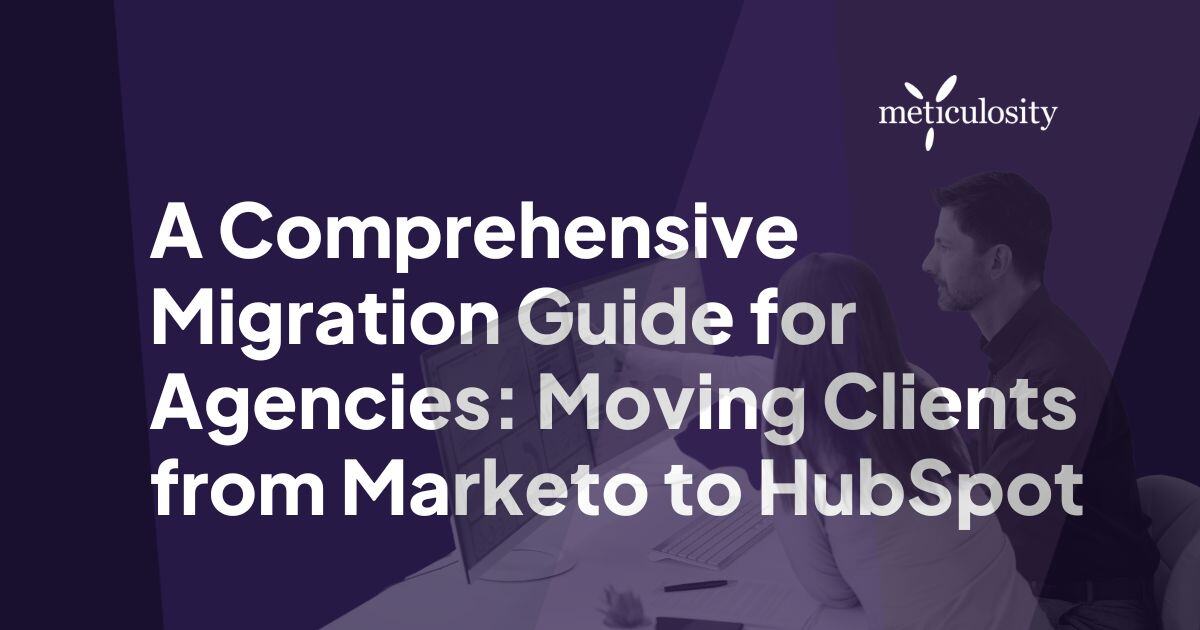Migrating your agency clients from Marketo to HubSpot is a strategic move that offers better integration, streamlined automation, and enhanced reporting.
However, without a clear roadmap, the transition can be complex. This guide will help your agency execute a smooth migration, ensuring minimal disruption to marketing operations while setting clients up for long-term success.
Ready to transform your agency's migration process? Explore our comprehensive HubSpot migration solutions and get started today!
Why Move Your Clients from Marketo to HubSpot?
Marketo is a robust platform, but many agencies and businesses opt to move to HubSpot for its user-friendly interface, native CRM integration, and all-in-one marketing, sales, and service capabilities. HubSpot’s intuitive tools and scalable solutions often provide a more streamlined experience, reducing the complexity and technical expertise required to manage campaigns effectively.
- Cost efficiency: HubSpot provides an all-in-one solution, reducing the need for multiple tools and costly add-ons.
- User-friendly interface: Unlike Marketo, HubSpot is designed for ease of use, allowing marketing and sales teams to work seamlessly without extensive technical knowledge.
- Advanced analytics and reporting: HubSpot’s built-in reporting tools offer deeper insights into campaign performance and customer interactions.
- Seamless integration with sales: HubSpot’s CRM and marketing automation tools create a unified ecosystem for lead nurturing and sales conversion.
Step 1: Assess the Scope of Migration
To avoid migration missteps, your agency must first establish clear objectives and a structured plan. Start by outlining:
- Migration goals: Define why your client is switching and what success looks like post-migration.
- Data requirements: Identify which data sets need to be transferred, such as contacts, automation sequences, lead scoring, and reporting metrics.

- Stakeholder involvement: Engage key stakeholders from marketing, sales, and IT to ensure alignment.
- Realistic timeline: Allocate time for data export, reconfiguration, testing, and team training to minimize downtime.
Step 2: Auditing the Existing Marketo Setup
Before migration, conducting a thorough audit of Marketo will help identify essential data, automations, and processes that need to be transferred. A detailed audit should include:
Reviewing Contact & Lead Data
Ensuring clean and accurate data is crucial for a successful migration.
- Remove duplicate, outdated, or irrelevant contacts.
- Verify GDPR and CCPA compliance for consent-based fields.
- Map Marketo fields to HubSpot to prevent data misalignment.
Assessing Automations & Workflows
Marketo’s automation rules don’t carry over to HubSpot directly, so agencies must document existing workflows:
- Identify active workflows, triggers, and actions that need to be rebuilt.
- Evaluate lead scoring methodologies and map them to HubSpot’s system.
Auditing Forms, Landing Pages & Email Templates
Not all Marketo assets will transfer automatically. Agencies should:
- List forms and landing pages that need to be manually recreated.
- Decide which email templates require rebuilding in HubSpot’s editor.
- Archive reports on form submissions and landing page performance for reference.
Step 3: Set Up HubSpot and Configure Key Elements Before Migration
Before importing data, agencies should configure HubSpot to match the client’s existing marketing structure:
- Customize CRM fields: Ensure that necessary fields from Marketo exist in HubSpot’s CRM.
- Set up permissions: Define user roles and access levels to maintain security and workflow integrity.
- Install tracking scripts: Add HubSpot tracking codes to client websites for accurate analytics.
Step 4: Exporting Data from Marketo
Marketo’s data must be extracted carefully to ensure completeness. Export the following:
- Contacts & Companies: Include all essential fields such as email, lead score, lifecycle stage, and segmentation.
- Engagement Metrics: Capture historical email engagement, form submissions, and interactions.
- Custom Objects & Lists: If applicable, extract segmentation lists and any additional custom properties.
Step 5: Data Migration and Validation
With data in hand, carefully import it into HubSpot, ensuring accuracy:
- Use HubSpot’s import tools for seamless data migration.
- Maintain unique identifiers like email addresses or CRM IDs.
- Validate data integrity post-import to catch any discrepancies.
Step 6: Rebuilding Automations & Workflows
Since Marketo workflows do not directly transfer, agencies need to reconstruct them in HubSpot:
- Recreate lead scoring models: Adjust Marketo-based lead scoring to fit HubSpot’s approach.
- Rebuild email automation sequences: Utilize HubSpot’s automation tools to maintain nurture campaigns.
- Redesign landing pages and forms: Leverage HubSpot’s drag-and-drop features to recreate assets.
Step 7: Testing & Validating the Migration
To avoid post-migration issues, conduct rigorous testing before full implementation:
- Run test campaigns to ensure automation flows function correctly.
- Validate that forms, landing pages, and CTAs are working as intended.
- Check CRM data for accuracy and consistency across records.

Step 8: Training Clients on HubSpot
A successful migration is only effective if your clients know how to use HubSpot efficiently. Agencies should:
- Provide hands-on training sessions for marketing and sales teams.
- Offer documentation on workflows, lead tracking, and reporting.
- Assign dedicated support personnel to address client concerns.
Step 9: Optimize and Monitor Performance
Once testing is complete, finalize the transition with a structured go-live process:
- Officially switch marketing automation to HubSpot while keeping Marketo as a backup briefly.
- Monitor engagement metrics, automation workflows, and CRM functionality.
- Conduct a post-migration review within 30-60 days to assess success and make refinements.
Overcoming Common Migration Challenges
While most data can be transferred, some aspects of Marketo do not migrate directly. Here’s how to tackle common limitations:
Handling Email & Engagement History
Marketo email sends, opens, and clicks do not transfer automatically. Agencies should:
- Export historical email engagement reports.
- Store previous engagement data as custom properties in HubSpot.
Rebuilding Lead Scoring Models
HubSpot’s lead scoring works differently from Marketo, so agencies must:
- Map lead scoring criteria and redefine point allocation in HubSpot.
- Use HubSpot’s predictive scoring tools if available.
Recreating Smart Lists & Automation Workflows
Marketo’s dynamic Smart Lists do not carry over. Agencies need to:
- Export Smart Lists as CSV files and manually rebuild them.
- Recreate automation workflows using HubSpot’s workflow editor.
Final Thoughts
Migrating from Marketo to HubSpot requires more than just a data transfer—it’s about optimizing your client’s marketing strategy. By planning carefully, testing thoroughly, and training teams effectively, your agency can turn this transition into a long-term advantage for your clients.
Ready to elevate your agency's migration process? Discover our comprehensive HubSpot migration solutions and start maximizing your clients' marketing potential today!
Frequently Asked Questions
1: How long does the migration process typically take?
It varies. Simple migrations might take weeks; complex ones could require months.
2: Will I lose any data during the migration?
Proper planning minimizes risk. Always back up and test before going live.
3: Can all Marketo features be replicated in HubSpot?
Most features transfer over, but some customizations may need workarounds.
4: How do I handle custom integrations during the migration?
Review your integrations. HubSpot’s native options often suffice, but custom work may be needed.
5: What training resources are available to help my team adjust to HubSpot?
HubSpot Academy, webinars, and tailored training sessions are excellent resources.
6: Is it necessary to work with a migration partner or consultant?
It is not required, but experts can simplify complex migrations.







